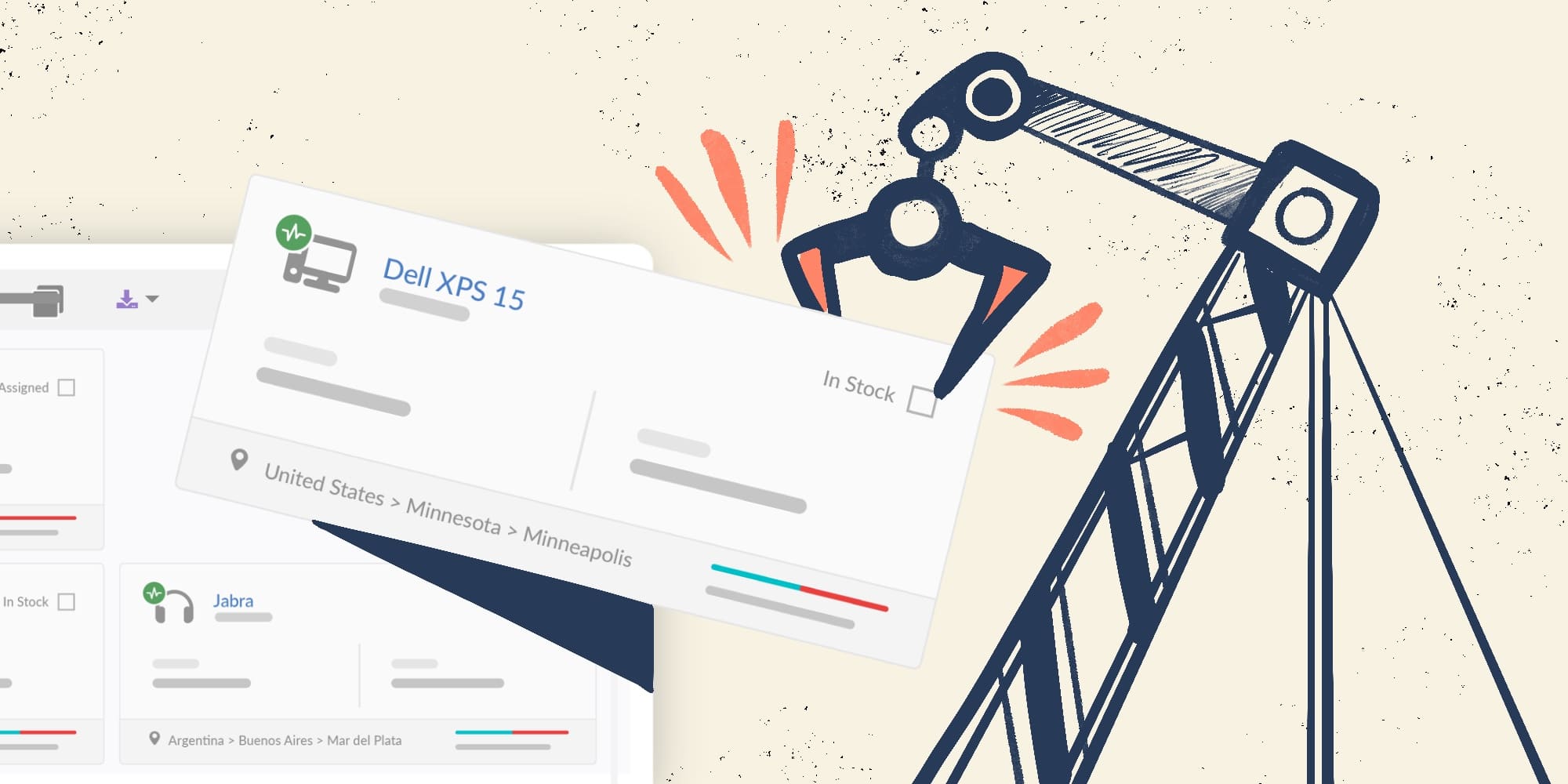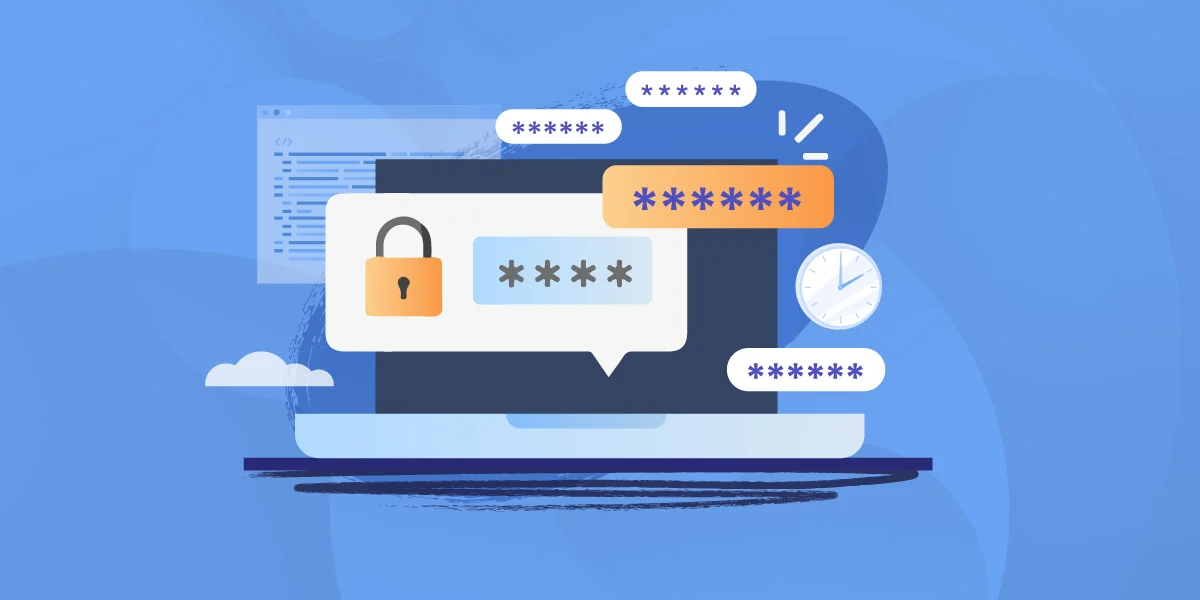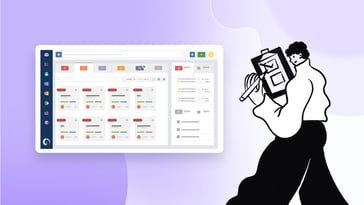There’s nothing scarier than picking up your phone and seeing a notification that someone has accessed one of your accounts. Chances are, it’s happened to you before—annoying at best, devastating at worst. Now imagine that scenario on a massive scale, with stolen credentials giving unauthorized access to sensitive systems at the company you work for. Pretty terrifying, right? That’s exactly why Identity and Access Management (IAM) exists.
In fact, the 2024 Verizon Data Breach Investigations Report reveals that stolen credentials were involved in 77% of hacking-related breaches, often through techniques like brute force or credential stuffing. Even worse, 65% of credentials sold in underground markets were posted less than 24 hours after being stolen, giving attackers a fresh arsenal for further breaches. These stats highlight just how crucial IAM is for protecting your organization against unauthorized access.
In this blog post, we’ll define exactly what IAM is and why it’s essential for any organization. Let’s explore how IAM serves as your frontline defense against cyber threats.

What is Identity and Access Management?
Identity and Access Management (IAM) is a comprehensive framework that ensures the right individuals in your organization have access to the right resources, at the right time, and for the right reasons. It’s the digital gatekeeper of your company, responsible for managing and securing user identities while controlling their access to systems, applications, and data.
At its core, IAM combines two critical functions: Identity Management and Access Management. Together, they prevent unauthorized access and minimize risks associated with stolen credentials, which, according to the 2024 Verizon Data Breach Investigations Report, are involved in 77% of hacking-related breaches. By implementing IAM, organizations can regulate who gets access to sensitive resources, ensure compliance with regulations, and safeguard against cyber threats like credential stuffing or brute force attacks.
IAM solutions typically include features like single sign-on (SSO), multi-factor authentication (MFA), and role-based access control (RBAC). For instance, SSO allows users to access multiple applications with one login, MFA provides additional layers of verification, and RBAC ensures that permissions are granted based on a user’s role. Maintaining MFA compliance further strengths security and ensures legal adherence, ensuring smooth MFA rollout. All of these ensure that organizations not only protect their data but also maintain seamless, secure workflows.
Identity Management vs. Access Management
While Identity and Access Management works as a unified framework, it’s built on two essential pillars: Identity Management and Access Management. These two practices are closely linked but focus on different aspects of managing users and their interactions with your systems. To better understand how IAM protects your organization, let’s break down each component and see how they contribute to the bigger picture.
What is Identity Management?
Identity Management focuses on managing who someone is in the digital environment. It involves creating, maintaining, and securing digital identities for users, devices, or applications. This process ensures that every individual or entity interacting with your systems has a unique, verifiable identity. In short, Identity Management answers the question: Who are you?
Key elements of Identity Management include:
- Creating and managing user accounts and credentials, such as usernames and passwords.
- Verifying identities through secure authentication methods, like SSO or MFA.
- Handling the entire lifecycle of a digital identity—from account creation to deactivation.
What is Access Management?
Access Management, on the other hand, governs what a verified identity is allowed to do. Once a user’s identity is authenticated, Access Management enforces policies and permissions that determine the level of access to resources, applications, or data and answers the question: What are you allowed to do?
Key aspects of Access Management include:
- RBAC, which grants permissions based on a user’s role within the organization.
- Enforcing least privilege principles, ensuring users only access what’s necessary for their job.
- Monitoring and auditing access to detect and address any unauthorized activities.
The four pillars of Identity and Access Management
To fully grasp Identity and Access Management (IAM), it’s essential to understand the four pillars that support its framework. These pillars are the strategic focus areas that guide the implementation and effectiveness of IAM. They provide a broader view of IAM’s goals, going beyond the operational aspects of Authentication, Authorization, and User Management.
Interestingly, one of these pillars—Access Management—also plays a dual role as both a foundational IAM practice and a strategic pillar. These are the four pillars of IAM:
- Identity Governance and Administration (IGA).
- Access Management (AM).
- Privileged Access Management (PAM).
- Identity Analytics and Intelligence.
#1. Identity Governance and Administration (IGA)
This pillar ensures that all identities (users, devices, and applications) and their access rights are managed in compliance with organizational policies and regulatory requirements. It answers the critical questions: Who has access to what? Why do they have access? Is it still necessary? Governance processes include periodic access reviews, enforcing policies, and ensuring the principle of least privilege.
#2. Access Management (AM)
Access Management is a key pillar that controls and regulates what authenticated users can do within your systems. It focuses on enabling secure, seamless access to resources based on defined policies, often involving tools like SSO, MFA, and RBAC.
Here’s where it gets interesting: Access Management is also one of the two main practices that form IAM (alongside Identity Management). As a practice, it handles the operational side of granting and restricting access. As a pillar, it broadens the focus to include strategic policies, system integration, and user experience. Think of it as the glue that ties user identities to their permissions and ensures those permissions align with organizational goals.
3. Privileged Access Management (PAM)
Not all access is created equal. PAM focuses on securing elevated permissions for users like system administrators, executives, or anyone with access to critical systems and sensitive data. These privileged accounts are prime targets for cyberattacks, so PAM tools and policies ensure they are closely monitored and protected.
For example, PAM might require additional verification for administrators accessing servers or limit the duration of elevated access to a specific task.
4. Identity analytics and intelligence
This pillar leverages data and analytics to provide insights into how identities interact with systems. It focuses on detecting unusual behavior, identifying security risks, and improving decision-making. For instance, if a user typically logs in from the United States but suddenly logs in from another country, the system can flag this as suspicious and prompt additional security measures. Identity analytics ensures that your IAM system is not static but adaptive, evolving with user behavior and emerging threats.

Understanding IAM technologies and why they matter
For an IAM system to function effectively, it needs to seamlessly integrate with various systems and applications. This is where specific standards and technologies come into play, ensuring secure, efficient, and scalable authentication and authorization processes. These technologies—Security Assertion Markup Language (SAML), OpenID Connect (OIDC), and System for Cross-domain Identity Management (SCIM)—are essential for enabling features like SSO, user provisioning, and cross-platform access.
By supporting these standards, IAM systems provide organizations with flexibility, security, and interoperability, making it easier to manage identities across diverse platforms and applications. Let’s break down these technologies and their importance:
-
SAML: The backbone of SSO, enabling users to securely access multiple applications after a single authentication. Its compatibility across systems ensures consistent and secure user experiences.
-
OIDC: Built on OAuth 2.0, it simplifies authentication for modern applications by transmitting user information through encrypted tokens, making it ideal for mobile apps, social media, and gaming platforms.
-
SCIM: Automates identity management by synchronizing user information across systems, ensuring that updates, additions, or deletions are reflected everywhere without manual intervention.
These technologies are crucial for organizations looking to implement IAM solutions at scale, supporting secure access, seamless user experiences, and efficient identity management.
Why is IAM important for your organization?
In today’s digital landscape, the best identity and access management solution ensures organizations of all sizes not only manage access but protect against emerging cyber threats. With threats like credential theft, unauthorized access, and data breaches on the rise, having a solid IAM framework isn’t just about security; it’s about ensuring efficiency, compliance, and trust. By managing user identities and access, IAM helps organizations operate securely while empowering their teams to work seamlessly.
Here are the five key benefits of implementing IAM systems in your organization:
#1. Enhanced security
IAM is your first line of defense against cyber threats. By using features like MFA, SSO, and RBAC, IAM ensures that only the right people access sensitive systems and data.
For example, consider an organization using MFA for all employees. Even if a hacker obtains an employee’s password, they’d still need the second factor—like a time-sensitive code from a mobile app—to gain access. This drastically reduces the risk of data breaches caused by credential theft.
#2. Streamlined user access
With IAM, onboarding new employees or granting access to specific systems becomes a breeze. Single sign-on allows users to log in once and gain access to multiple applications without juggling passwords.
For example, a new marketing employee might need access to tools like Google Analytics, Salesforce, and Slack. Instead of managing separate accounts for each platform, IAM enables centralized access control, ensuring they get to work quickly without compromising security.
#3. Regulatory compliance
Many industries, such as healthcare (HIPAA), finance (PCI DSS), and others, are required by law to manage access to sensitive information. IAM simplifies compliance by automating access controls, logging user activity, and generating audit-ready reports.
Imagine a healthcare provider using IAM to restrict access to patient records. Doctors can view the files they need for treatment, but administrative staff are limited to billing information. This setup ensures compliance while protecting sensitive data.
#4. Reduced operational costs
IAM saves time and resources by automating routine tasks like password resets, user provisioning, and deprovisioning. IT teams can focus on strategic projects rather than manually managing access.
For instance, an organization with automated IAM tools can revoke access to all systems immediately when an employee leaves, preventing lingering accounts from becoming security risks. This efficiency reduces both IT workload and potential breaches.
#5. Improved user experience
A well-implemented IAM system makes life easier for users. Instead of remembering dozens of passwords, employees use SSO and can easily recover access through self-service password management.
Take the example of an HR employee who accesses multiple tools daily. With IAM, they don’t need to log in repeatedly, boosting productivity and eliminating the frustration of forgotten passwords.

How do Identity and Access Management and IT Asset Management relate?
IAM and IT Asset Management (ITAM) are like two sides of the same coin—working together to keep your organization secure and efficient. While IAM focuses on who can access what, ITAM handles the what by tracking and managing your tech assets like laptops, servers, and software. They’re the dream team for keeping your IT environment running smoothly and safely. Here’s how they click:
#1: Secure access to IT assets
IAM is all about keeping your stuff safe by letting only the right people in, while ITAM makes sure you know what "stuff" you actually have. Think of it this way: ITAM gives you a full inventory of all your laptops, apps, and servers, and IAM steps in to say, "Only the engineers get access to the dev server." This perfect handoff ensures your assets stay secure.
#2: Lifecycle Management and permissions
ITAM follows your assets from cradle to grave, while IAM handles who can use them along the way. Say you have an employee leaving the company. ITAM marks their laptop as "decommissioned," and IAM swoops in to revoke their access to all company systems. No forgotten accounts, no lingering risks—just a smooth, secure process.

#3: Audit and compliance
Compliance can feel like a daunting checklist, but IAM and ITAM team up to make it manageable. ITAM tracks where your sensitive data lives, while IAM keeps tabs on who’s accessing it. For example, during a GDPR audit, ITAM can show that patient records are stored securely, and IAM can prove only authorized medical staff have been poking around. Together, they help you dodge fines and stay in the compliance safe zone.
#4: Mitigating risks in shadow IT
Shadow IT is like a party you didn’t know was happening in your house. ITAM identifies those uninvited guests (like unapproved file-sharing apps), and IAM keeps the door locked until IT gives them the green light. Imagine spotting employees using a new app without telling IT—ITAM flags it, IAM blocks access, and the app doesn’t cause security chaos.

#5: Enabling collaboration between IT teams
IAM and ITAM make IT teamwork dreamwork. ITAM highlights your most critical assets, and IAM watches who’s coming and going. Picture this: ITAM points out that your main server is critical, and IAM notices a suspicious login attempt. Together, they alert your security team to shut down a potential threat before it becomes a full-blown disaster.
7 best practices for implementing Identity and Access Management
Implementing Identity and Access Management isn’t just about deploying tools—it’s about creating a secure, efficient framework that protects your organization while enabling seamless access. To get it right, follow these seven best practices:
1. Adopt the principle of least privilege
Grant users only the access they need to perform their job—nothing more, nothing less. This minimizes the risk of accidental or malicious misuse of data. For example, an intern in marketing doesn’t need access to the HR payroll system. By limiting permissions, you keep sensitive resources under tighter control.
2. Use Multi-Factor Authentication (MFA)
MFA adds an extra layer of security by requiring users to verify their identity with something they know (a password) and something they have (a phone or a biometric scan). Even if a hacker gets hold of a password, they won’t have the second factor to complete the login. Think of it as a security double-check that keeps intruders out.
3. Implement Role-Based Access Control (RBAC)
Organize access based on job roles to simplify permission management. For instance, all engineers might have access to development servers, while sales staff have permissions for CRM tools. This approach not only improves security but also makes onboarding and offboarding employees a breeze.
4. Monitor and audit access regularly
Keep tabs on who is accessing what, and review permissions periodically. Regular audits help identify outdated accounts or excessive privileges. For example, if a former employee’s credentials are still active months after they’ve left, it’s a security ticking time bomb waiting to happen.
5. Use Single Sign-On (SSO) for convenience and security
SSO allows users to access multiple systems with one set of login credentials. This reduces the need for juggling multiple passwords (and the temptation to reuse them) while simplifying access management for IT. Plus, it’s a win for employees who no longer have to remember dozens of logins!
6. Educate your team about security best practices
Technology alone isn’t enough—people are often the weakest link in security. Train employees on recognizing phishing attempts, creating strong passwords, and using secure authentication methods. A little awareness goes a long way in preventing breaches caused by human error.
7. Integrate IAM with other systems
To get the most out of IAM, integrate it with tools like IT Asset Management (ITAM), HR systems, and cloud platforms. For instance, syncing IAM with ITAM ensures that when a new laptop is issued, access permissions are automatically set up based on the user’s role, saving time and reducing errors.
8. Enable adaptive authentication
Not all login attempts are created equal. Adaptive authentication uses context—such as location, device, time of access, and user behavior—to determine the risk of a login attempt and adjust the security requirements in real-time. For example, if an employee suddenly logs in from a new country, the system can prompt for additional verification steps before granting access. This ensures tighter security without adding unnecessary friction for trusted scenarios.

Conclusion
Implementing Identity and Access Management (IAM) is no longer optional—it’s essential for protecting your organization’s sensitive data, improving operational efficiency, and staying ahead of cyber threats.
By following these best practices, you can build a robust IAM framework that not only keeps intruders out but also empowers your team to work securely and efficiently. It’s time to embrace IAM as your organization’s digital guardian and step confidently into a safer future!















